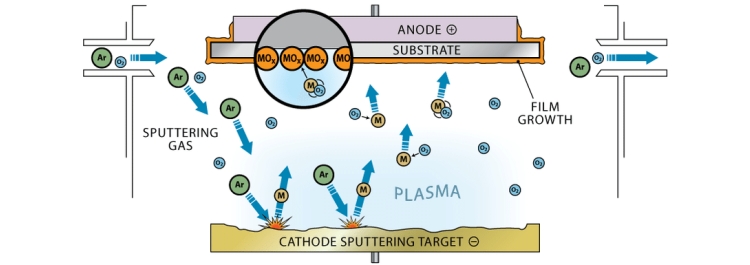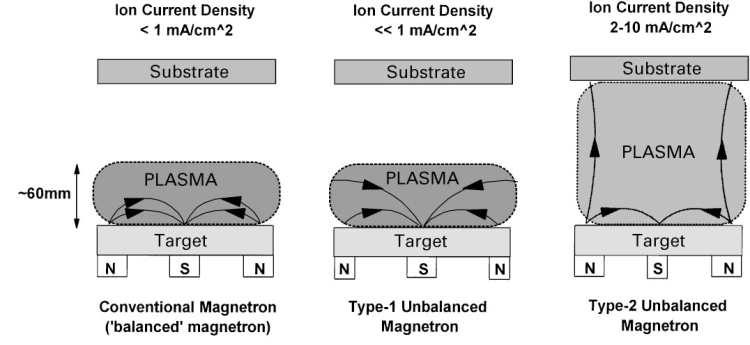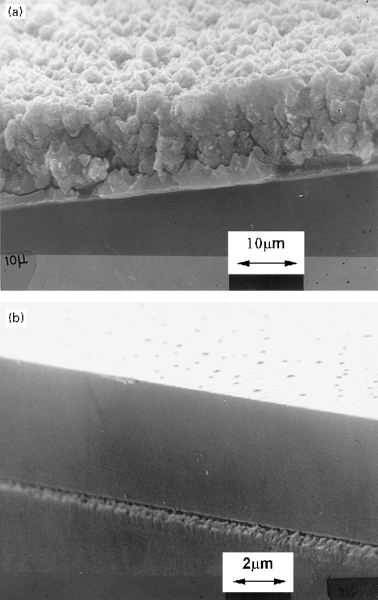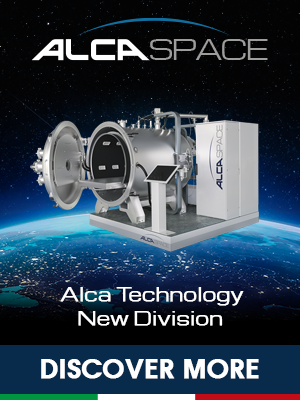Magnetron Sputtering

Introduction
Magnetron sputtering has developed rapidly over the last twenty years, following the increasing industrial demand for high-quality functional films. Today, magnetron sputtering often outperforms other techniques used for the deposition of coatings of industrial interest.
The conventional magnetrons, developed in the early 1970s, were an important step in overcoming the limitations of the early sputtering process, which has been known and used for many years despite its limited industrial capability. Then, the advent of unbalanced magnetron in the late 1980s, and the development of multi-source 'closed-field’ systems in the early 1990s changed the game again, offering to the industry a set of exceptionally versatile and performing deposition technologies. A further, recent development, the pulsed magnetron sputtering (PMS) lead to the capability of depositing fully dense, defect-free coatings of insulating materials, particularly oxides at high deposition rates, avoiding arcing and improving the quality of the deposit.
Magnetron sputtering
In the early, basic sputtering process, a target (or cathode) plate is bombarded by energetic ions coming from a glow discharge plasma: essentially, the ions act as tiny meteorites, which strike the target surface, leading to the expulsion, i.e., 'sputtering', of target atoms. The latter, being usually neutral, can freely fly away from the target, eventually impacting the surface of a substrate, where they condense as a thin film. The ion impacts lead also to the emission of secondary electrons from the target surface, which helps is sustaining the plasma. This former process suffers of low deposition rates, and high substrate heating effects, and is not suitable for the sputtering of insulating materials.
Magnetron sputtering overcomes these limits, using a magnetic field parallel to the target surface to capture secondary electrons, keeping them in the vicinity of the target. This trapping effect increases the plasma density in the vicinity of the target, leading to an incremented number of meteorites hitting the target itself, of sputtered atoms and, finally, to higher deposition rates at the substrate.
In a conventional magnetron the plasma is confined to the region close to the target: the substrate can be positioned within this region or outside it. In the first case, it will be subjected to a concurrent ion bombardment, which can have a strong influence on the structure of the deposited film, possibly making it more dense, and def. If, instead, the substrate is placed outside the plasma region, the ion bombardment and its effects cease. If a large component has to be coated, it can be negatively biased, thus increasing the ion bombardment effect. Often, however, this leads to more defective and stressed films, due to the increased ions kinetic energy.
To solve the problem of having a high flux of low energy ions, which is the ideal condition to get dense and high-quality films, unbalanced magnetrons have been invented.
Unbalanced magnetron sputtering
Unbalanced magnetrons have a “leaky” magnetic field, in the sense that not all the field lines are closed between the central and outer poles. Some field lines extends to the substrate, which allows some secondary electrons to follow them. Consequently, the plasma extends towards the substrate, leading to high ion currents flowing to it. Moreover, these ions are low energy particles, i.e. best suited for coating restructuring, and ideal to get the best deposit properties. Windows and Savvides were the scientists which first studied in depth this technology, showing that with unbalanced magnetron the ion flux can be up to ten times that achievable with conventional magnetrons.

Representation of different magnetron operating modes - From [1]
As a final remark, it should be noted that with unbalanced magnetron, the ion-to-atom substrate arriving ratio doesn’t change varying the deposition rate, thus simplifying the process management.
Closed-field unbalanced magnetron sputtering
To uniformly coat complex components at acceptable rates, multiple source have to be considered. In a multiple magnetrons system, the magnetic fields can be arranged with either identical, or opposite magnetic polarities. In the first case, we have a “mirrored” configuration, where the field lines diverges to the vacuum chamber walls, thus leading to low plasma density around the substrate. In the second case, we have in turn a “closed field” configuration, where the field lines are linked between the magnetrons. This lead to a high density plasma region around the substrate, which can be some 2–3 times greater than that obtained under the same conditions in the mirrored, or single unbalanced magnetron configurations.
The multiple magnetron systems are ideally suited to the deposition of multi-component materials, as each of the magnetron targets can, in principle, be of a different material. This can be done also using reactive gases, leading to the possibility of depositing high quality nitrides, oxides, etc.
Moreover, by sputtering the targets at different rates, any desired alloy composition can be attained. Further, by varying either the sputtering rates, or the gas mixture composition during deposition, composition, and, therefore, properties can be graded through the thickness of the coating, thus optimizing the desired coating properties.
Pulsed magnetron sputtering
The sputtering deposition of insulating materials poses some difficulties: charging of the target and arcing, stoichiometry control and poisoning in reactive sputtering systems, low deposition rate and high costs for RF (Radio Frequency) sputtering. The pulsed magnetron sputtering (PMS) process has been purposely developed to overcome these problems, and thus for the production of highly insulating films.
By pulsing the magnetron discharge in the medium frequency range (10–200 kHz) the formation of arcs can be strongly reduced, leading to better deposit quality, while achieving deposition rates approaching that of pure metal (tens of microns per hour). PMS power supplies are sophisticated -and expensive- pieces of equipment, with a variety of operating modes, and tunable process parameters available; nevertheless, for some difficult to deposit insulating materials, they have become the elective choice. The reason for this is apparent in the following images, where the resulting deposit of Al2O3 with DC reactive spattering vs. PMS can be visually compared: the PMS coating has a stoichiometric Al2O3 composition, and is extremely dense with little defect density and structural inhomogeneities.

SEM micrographs of the fracture sections of aluminium oxide deposited by (a) DC reactive sputtering, and (b) PMS. – From [1]
Bibliography
[1] https://doi.org/10.1016/S0042-207X(99)00189-X - P.J Kelly, R.D Arnell, Magnetron sputtering: a review of recent developments and applications, Vacuum, Volume 56, Issue 3, 2000, Pages 159-172, ISSN 0042-207X.
[2] https://doi.org/10.1116/1.4998940 - E. Greene, J. (2017). Review Article: Tracing the recorded history of thin-film sputter deposition: From the 1800s to 2017. Journal of Vacuum Science & Technology A: Vacuum, Surfaces, and Films. 35.
[3] https://doi.org/10.1016/B978-0-8155-2031-3.00005-3 - D. Depla, S. Mahieu, J.E. Greene, Chapter 5 - Sputter Deposition Processes, Editor(s): Peter M. Martin, Handbook of Deposition Technologies for Films and Coatings (Third Edition), William Andrew Publishing, 2010, Pages 253-296.


